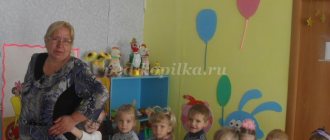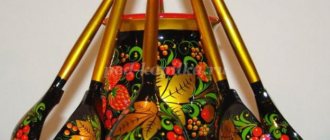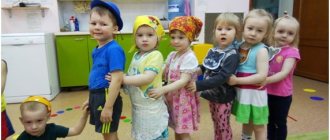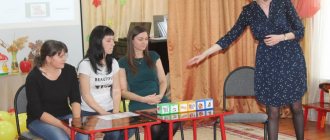Work experience “Oral folk art in the development of children’s speech activity”
— determine the importance of oral folk art in the development of speech
preschoolers;
-improvement of dialogic and monologue speech;
- education of aesthetic feelings when getting acquainted with examples of oral folk art;
-increasing the competence of parents in the development of children’s speech;
— conduct a study of the influence of oral folk art on the development of children’s speech activity.
To achieve the set goal and solve problems, an appropriate developmental subject-spatial environment has been created in the group.
The interior of the group includes elements of Russian decorative arts and crafts: aids in play corners, soft toys made of fabric, various types of theaters, folk dolls. In addition, a large role is given to folklore in the planning of educational activities and regime moments. Understanding that improving verbal communication is impossible without expanding the child’s vocabulary, much attention is paid to consolidating and activating it. Classes on cognitive development with elements of folklore, in which children became acquainted with the attributes of the upper room, significantly expanded the children's vocabulary. In order for new, rather difficult words to become firmly established in children’s vocabulary, she used various methodological and gaming techniques.
Children's acquaintance with folk art begins with nursery rhymes and
lullabies
. Getting to know nursery rhymes begins with looking at pictures, illustrations, and toys. Having given the children the opportunity to examine the toy, I tell them about the character in the nursery rhyme and his features. In a preliminary conversation, I explain the meaning of the new words that the children will hear in a nursery rhyme. Before reading the nursery rhyme “Horse” to children, they already had an idea of what a beautiful, proud animal this is. While washing and combing the children's hair, she introduced them to songs.
It’s nice to watch how children use nursery rhymes while playing “mother-daughter” and how carefully and lovingly they treat their dolls.
The children have grown up. I began to select nursery rhymes for them with more complex meanings. During the theater classes for children, the task was set not only to remember the nursery rhyme, to read it emotionally, but also to act it out themselves. The whole group of children learned to move and talk like a fox, a hare, a bear, a chicken, a hedgehog, etc., depending on who the nursery rhyme is about. Folklore provides excellent examples of Russian speech, imitation of which allows a child to more successfully master his native language.
Proverbs and sayings are called the pearls of folk art; they affect not only the mind, but also the feelings of a person. The teachings contained in them are easily perceived and remembered. Proverbs and sayings are figurative, poetic, endowed with comparisons, vivid epithets, they contain a lot of personifications and small definitions. The proverb can be used in any situation. The children are going for a walk. We remind the slow Artem: “Seven do not wait for one.” Noticing that Sasha dressed sloppily, we say: “If you hurry, you’ll make people laugh.” During walks, proverbs help children better understand various phenomena and events..
MAGAZINE Preschooler.RF
Oral folk art in the development of preschooler speech.One of the most important tasks facing our society is raising a child with well-developed speech. This is due to its social significance and role in the formation of personality. It is generally accepted that communication is one of the main conditions for the development of a child, an essential component in the formation of his personality, behavior, and emotional-volitional processes.
I believe that one of the effective means of developing the speech of preschool children is folklore - oral folk art. This is due to the fact that, in connection with the requirements of the Federal State Educational Standard of Preschool Education, the educational activities of preschool education are focused on the development of the child’s personality, his spiritual and moral characteristics and interests, therefore, I consider the actual goals of his activities as a teacher to be the activation and stimulation of interest in works of oral folk art - jokes , nursery rhymes, chants, fairy tales, folk songs and games, to traditional national customs, rituals, and folk culture.
When using oral folk art as a means of developing the speech of preschool children, I identify three optimal approaches: integrated, communicative and system-active.
With an integrated approach to solving the problems of the educational areas “Socio-communicative development” and “Speech development” is carried out: in all main areas of the educational program of preschool education; in all forms of children's activities - direct educational activities, joint activities of children and the teacher, independent activities of children; in different types of children's activities (play, cognitive, labor, productive, musical, etc.) and in routine moments.
In the communicative approach, works of oral folk art are used for communication between an adult and a child, for example, when reading and discussing works of art, holding conversations, and finger games. This expands the vocabulary, forms the grammatical structure of speech, its sound culture.
In the process of a system-active approach, small forms of folklore are used purposefully and systematically (in all types and forms of children's activities, in regime moments) and it is taken into account that most works of oral folk art were created with the aim of developing the motor activity of children, which has a positive effect on speech activity . With this approach, I organize outdoor folk games, round dances, folklore festivals, etc. for children.
To develop the speech of preschool children, I can use works of art and introduce children to the treasury of Russian and world literature. Children's acquaintance with the best examples of oral folk art should begin from the first years of their life, since the period of early and preschool childhood is a defining stage in the development of the human personality. The age of up to five years is the richest in a child’s ability to quickly and greedily learn about the world around him and absorb a huge amount of impressions.
It is during this period that children, with amazing speed and activity, begin to adopt the norms of behavior of those around them, and most importantly, to master the means of human communication - speech. By mastering speech, the child receives the key to understanding the surrounding natural world, things, and human relationships.
The baby’s first acquaintance with oral folk art begins with a lullaby, which soothes and sets the baby up for rest; affectionate, gentle, quiet. People call them bikes. This name comes from the verb “bayat” , “bait” - to speak. Lullaby stories chose a cat as their “hero ,” since it was believed that the peaceful purring of a cat brings sleep and peace to the child.
For better awakening, knowledge of the environment and games, I use such types of oral folk art as nursery rhymes, pestushki, jokes, teasers, tongue twisters, etc.
To the sounds of their affectionate, melodious words, the baby will wake up easier, let himself be washed ( “Water, water…” ), fed ( “Grass-ant…” ). Not always pleasant moments of caring for a child while listening to songs turn into that emotional contact, into those forms of verbal communication that are so necessary for his development.
A better understanding of fairy tales and poems is helped by staging them with the help of toys and table theater. Dramatization and theatrical games based on the plots of Russian folk tales contribute to the development of dialogical and monologue speech skills in preschool children. Before the performance, I give the children the opportunity to look at future “artists” - toys, flat figures, so that the kids can then focus more on auditory impressions.
With the help of folk songs, phonemic hearing develops, as they use sound combinations - tunes that are repeated at different tempos, with different intonations.
The world of oral folk art in guessing and making riddles is diverse and inexhaustible; we meet them in fairy tales where heroes must not only show strength and courage, but also ingenuity and dexterity in solving riddles.
Tongue twister is a form of small folklore that is used to improve diction and eliminate pronunciation problems. Tongue twisters contribute to the development of correct speech, reinforce the correct pronunciation of sounds, for training and improving the vocal apparatus, and develop the child’s hearing.
Using the entire “arsenal” of oral folk art in their practice, children learn to express their feelings and thoughts clearly, concisely, expressively, coloring their speech intonationally, develop the ability to creatively use the word, the ability to figuratively describe an object, and give it a vivid description. Folklore genres allow the most complete development of children's coherent speech, expand children's vocabulary, activate their cognitive and mental development, develop sound pronunciation, children are interested in turns and expressions of folk speech.
As a result of my work, I was convinced that oral folk art is an effective development of speech for preschool children. Folklore works arouse keen interest and attract the attention of children with their short form, vivid poetic images and artistic means, evoking positive emotions in children. All this together increases the effectiveness of work on the speech and social-communicative development of children, makes children’s speech more correct, expressive, bright and melodic.
| Next > |







